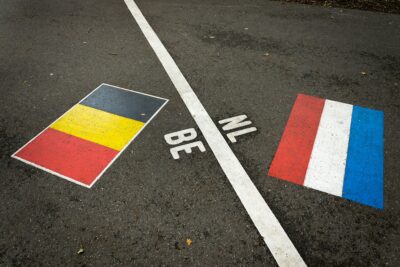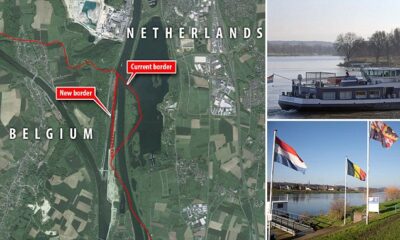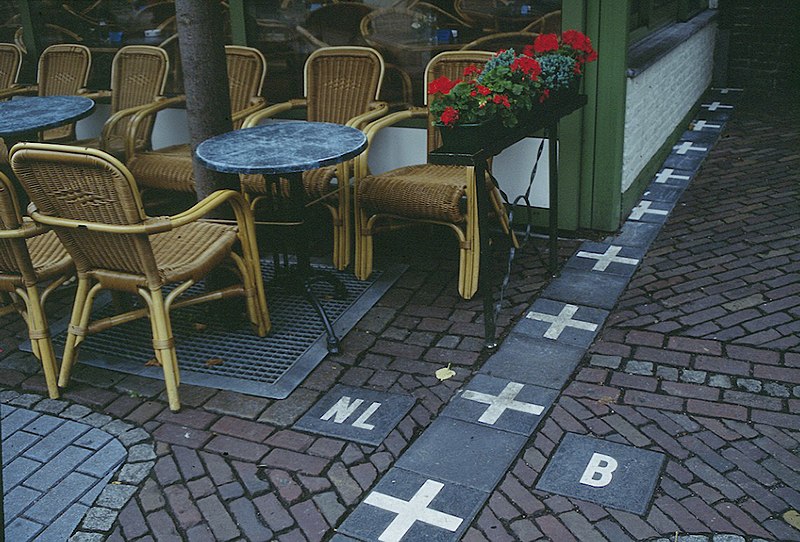Belgium (Brussels Morning Newspaper), The crisis at America’s southern border is the most pressing issue (assuming you believe the polls) facing voters in this election year. On the other side of the globe, Russia and Ukraine struggle over border issues of a different iteration. Certainly, the line between Gaza and Israel is front-page news. Since 1945 the North/South Korea border has been a classic example of a contentious border.
Add to the list: China and Taiwan, India and Pakistan, and it is safe to say that “border disputes” are, and historically have been, hot-button issues. This article directs your attention to Belgium’s borders but on a very much lighter note. Belgium’s borders have a story to tell which is sometimes arbitrary, sometimes illustrative, and many times humorous.
Present-day Belgium has 1384 km. of land boundaries with its neighbors: The Netherlands, Germany, Luxembourg, and France with an additional 60km. of shoreline on the North Sea. These delineations were drawn up by the Treaty of London (1830) where the major powers of Europe sought to draw up a “buffer state” between France, the Netherlands, and Prussia. The Napoleonic wars were still fresh in the memories of the major European powers and the thought of a Belgian buffer state seemed the most expedient and practical solution. Thus, Belgium obtained de facto independence from the Netherlands in 1830.

Today, the Belgium/ Netherlands border is 480km with a total of 365 concrete border posts that mark the actual border. As per the European Union’s policy of free movement, people travel seamlessly across the border. However, it gets a little complicated around the village of Baarle where the territory is divided into a patchwork of both Belgian and Dutch elements. The confusion is a remanent of the feudal era where the line was blurred between ownership and serfdom— between who owns the land, who lives on the land, and who works the land. The
The Belgian section of the border, called Baarle-Hertzog, includes 16 enclaves within Dutch territory. In turn, there are a dozen or so Dutch exclaves (named Baarle-Nassau) surrounded by Belgium. The line of the border is such that some buildings straddle both countries. Zeeman Discount Store, for example, uses caution tape to separate parts of the store that fall on the Belgian side of the border and those on the Dutch side. For properties like this, the “ voordeurregel” policy (literally: “front door rule”) applies whereby the legal address lies in the country that contains the front door. For convenience, every house number plaque shows their applicable country’s flag.
Both enclaves have their own mayors and elected town councils that look after electricity, gas and refuse collection. Dutch legal systems apply to the Dutch parts of Baarle-Nassau while Belgian laws apply to Baarle-Hertog. Both enclaves share a cultural center that has two entrances as the facility is bisected by the border line. They also share a library with both Belgian and Dutch staff. Baarle’s situation has been called “the most complicated international border in the world.”
The river Meuse (Maas in Dutch) is 925km in length and is the longest river to pass through Belgium. With its headwaters rising in France, flowing through Belgium and the Netherlands, the Meuse ultimately drains into the North Sea. The river, like all rivers, can change course over time due to flooding, erosion, and human interventions. Such was the case near Eijsden Netherlands and Lanaye, Belgium. In the 1960’s the Meuse was straightened and dredged throughout 4 km. to better accommodate some locks and canals. This changed the border dynamic between Belgium and the Netherlands. In November of 2015, the Belgian and Dutch authorities acknowledged not a “border dispute” per se but rather a “land swap.”
By agreement, Belgium would cede a small peninsula (about the size of 28 football pitches or 14 hectares) to the Netherlands. Belgium in return would receive a small peninsula of Dutch territory. The reasoning behind this “swap” was so that the jurisdictional status of each plot would become more convenient. Now Belgian law enforcement did not need permission to transit into Dutch territory and the Netherlands was granted 32 net hectares of uninhabited wetlands. In November of 2017, King Philippe traveled to Amsterdam to formally sign the “swap” thus completing a friendly, common sense, win/win solution that redrew the Belgian/Netherlands border.

In May 2021 a Belgian farmer caused an “international incident” by redrawing Belgian’s border with France. The farmer, annoyed with the stone border marker in his tractor path, moved the marker 2.29 m. into French territory. The incident was met with smiles on each side of the border. “He made Belgium bigger and France smaller and that is probably not a good idea said the mayor of the Belgian village of Equelinnes, David Lavaux. “I was happy my town got bigger” he added “but the mayor of nearby Bousignies-sur-Roc might not agree. Regardless we should be able to avoid a new border war…We laugh about this more than anything else! ” added Mr. Lavaux with a chuckle.
This stone dates to 1819 and is one of hundreds of border demarcations that mark the French/Belgium border. Maintenance of and disputes regarding the line are managed by a mixed Belgian/French delimitation commission that convenes when required.
To be sure, any serious discussion of Belgium’s borders must include those that were not so lighthearted. For example, in World War I (1915) Germany built a high-voltage 2,000-volt electric fence along the Belgian-Dutch border to “stop all disturbing border activity that might severely harm the military operations” of the occupying German army. Their strategy was to detain Belgians inside their border as 1 million had fled into the Netherlands. Another example is Napoleon’s actions in 1850. Hoping to extend the French territories by crossing into what is now Belgium, Napoleon met his political/military demise from troops from the United Kingdom, the Netherlands, and Prussia. Think; The Battle of Waterloo— perhaps one of history’s bloodiest “border disputes.”
As tensions continue to mount along the Rio Grande, the Gaza Strip, and Kyiv, perhaps some of Belgium’s more lighthearted border solutions might offer some optimism. It may be a stretch but hopefulness, amiability, and confidence about the future is, at least at the margins, a possibility!



